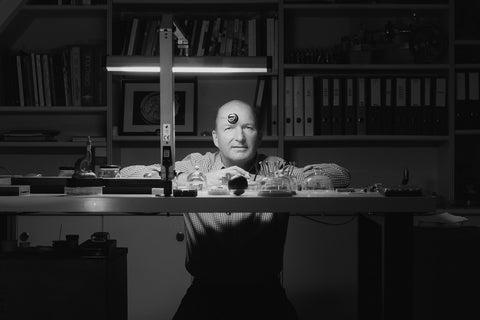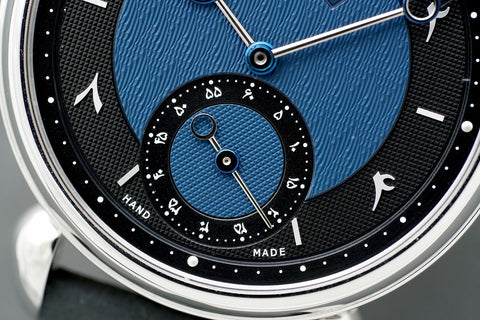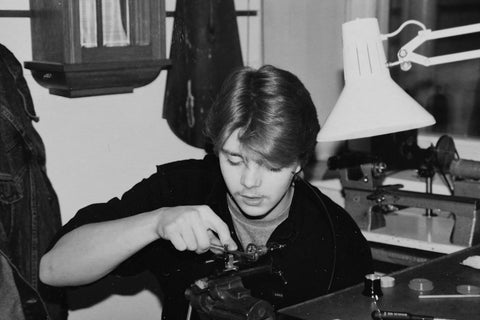The name Kari Voutilainen conjures up images of a technicolour body of work, thanks in part to the collaborative nature of his method and the many customisation offers in series including the Vingt-8. However, an area of Voutilainen's work that is under-explored and hardly ever seen on the market, understandably due to the rarity of these projects, is his bespoke work. This watch is one such example, as it was built entirely from the ground up as a one-off to the commissioning client’s specifications and as such is a unique piece in almost every sense.
Right from when the watch was first commissioned in 2007, Voutilainen collaborated closely with the client and estimated that he could deliver it by 2010. However, the intensive nature of the project, compounded by the iterative nature of such commissions and the growing size of his manufacture meant that it would only be delivered in June of 2018. It represents the outer limits of what a watchmaker of Voutilainen’s abilities can achieve when set free of any constraints. It represents a high point in independent watchmaking of the last few decades.
The platinum case, measuring 38mm across, is an unusual size that sits in between the typical 39, or 39.5mm, and 37mm case sizes Voutilainen favours. Aesthetically it is classical, with a three-part case that is evenly high polished. The lugs, teardrop-shaped, are exactly what you expect from the maker. The crown is substantial, relative to the size of the case, aiding ergonomics.
On the dial side, the TBR-1 Prototype is beguilingly simple, only its tourbillon hinting at the treasures that lie within. The dial, crafted from a solid gold base, is quintessentially Voutilainen, with its tidy layout and liberal application of engine-turned guilloché, done by hand. A chapter of Roman indices sits on a rim of Clous de Paris decoration, while further in the dial wears a wave pattern in a roseate radiating from the centre. A smooth chapter with minute plots run on the outer reaches of the dial, while a similar moat separates the two patterns of guilloché further in. The Observatoire hands, with applied blued aperture ends, complete the picture. Notably, the minute hand progresses in precise, instantaneous increments, in sync with the function of the remontoire.
A large aperture at 6 o’clock houses the semi open-work one-minute tourbillon. The four arms of the regulating device, butterfly-like in form, wear beautiful bercé polishing, as do the twin arms of the tourbillon bridge. Crowning the cage is a jewel in chaton, topped by a seconds hand that allows the wearer to test the chronometric performance of the calibre. The balance wheel at the heart of the large tourbillon is proportionally sized and features four rose gold weights. It has a self-compensating balance spring with Grossman curve and the escapement is of the Swiss lever variety, with an anchor crafted from titanium. Visible through this aperture in the dial is the brass bridge underneath that anchors the tourbillon on the movement side.
Turning over the watch, visible through the sapphire caseback, is the manual-wind calibre. Measuring 32mm across, the architecture is wholly different to anything to be found in any of the watchmaker’s serially produced pieces. It is however vaguely reminiscent of the first Tourbillon Pocketwatch Voutilainen ever made. The bridges that support the twin mainspring barrels, arranged in sequence, almost reflect each other’s form. Together they afford the calibre almost 90 hours of autonomy. The flowing ends of the bridges, ending in sharp corners, feature beautiful anglage with high polishing. The constant force mechanism, key to the smooth and even delivery of energy, is incorporated into the going train – the device sits on the third wheel, anchored by a Vulcan-shaped, black polished bridge. The rose gold wheels, together with the frosted finish of the bridges and the perlage on the baseplate, presents a uniformly warm appearance. One of the bridge’s anchoring a mainspring wear the brand mark and “TBR-1”, hand-engraved in a cursive script.
As per the commissioning client’s request, the watch was certified an observatory Chronometre at the Besançon Observatory. It comes with the certificate that notes the timing data. In addition to the bill of sale and warranty paperwork, the TBR-1 Prototype comes with a specification sheet, a beautiful wooden inner box and a copy of Voutilainen: Horlogerie D'Art.



















































































































































































































